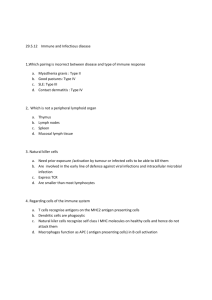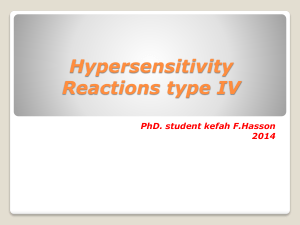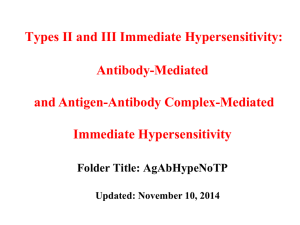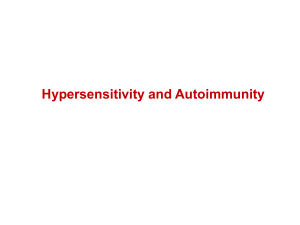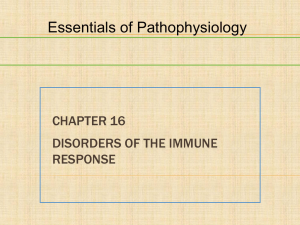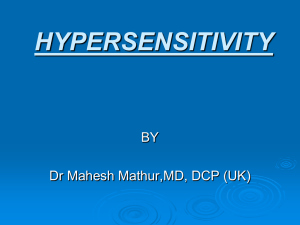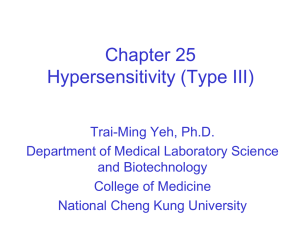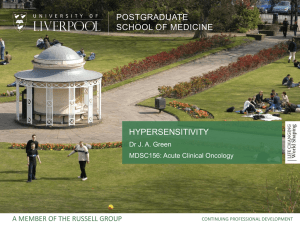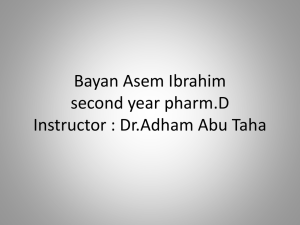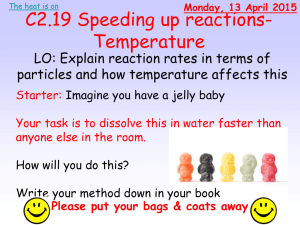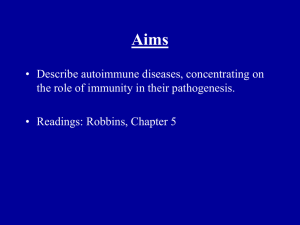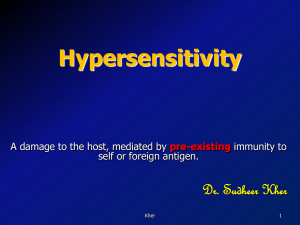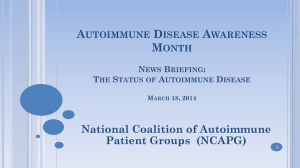Immunopathology
advertisement
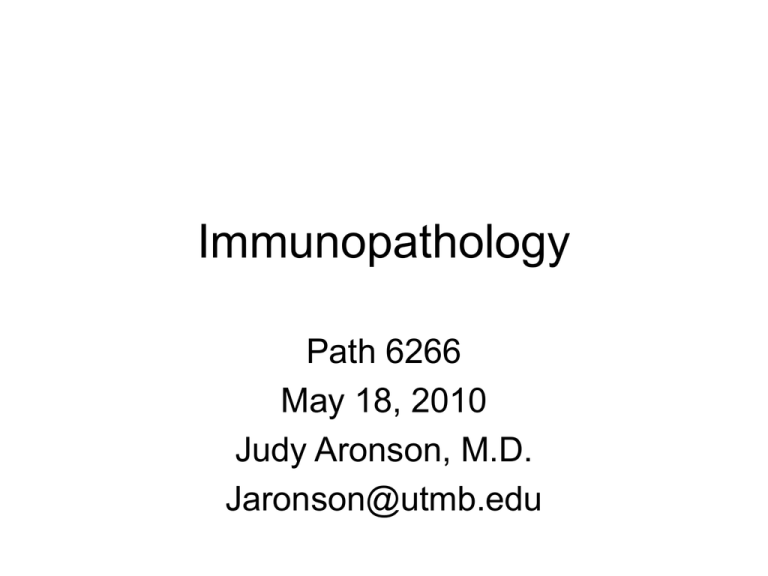
Immunopathology Path 6266 May 18, 2010 Judy Aronson, M.D. Jaronson@utmb.edu Outline • How does the immune response damage tissues? – Hypersensitivity mechanisms – Examples of immunopathologic disease – Autoimmune diseases • How does autoimmunity occur? – Mechanisms of peripheral tolerance – Lessons from an experimental model of autoimmune diabetes The double edged sword of immune responses “Immunitas”: Freedom from disease “Pathos”: Suffering/ disease Protective responses against infectious agents Host tissue damage by immune response Hypersensitivity reactions • Mechanisms of immune-mediated injury • Classified into 4 types (I-IV) • Imperfect correlation between hypersensitivity reaction and disease syndrome – In some diseases, all 4 types may contribute – Humoral and cell-mediated mechanisms may coexist Categories of diseases with immunopathologic components • • • • • Infectious Allergic Transplant rejection Graft vs. host disease Autoimmune Hypersensitivity Reactions • Type I: anaphylactic – allergy, asthma • Type II: antibody-mediated – transfusion reaction • Type III: immune complex-mediated – post-strep glomerulonephritis • Type IV: cell-mediated, delayed type – tuberculosis Type I hypersensitivity • Immunoglobulin E (IgE) – made by plasma cells, specific for allergen • Mast cells, basophils – Have receptors for Fc portion of IgE molecule – When antigen binds IgE variable regions, degranulation of cells occurs – Histamine and other vasoactive substances are released • Severe reactions can be life-threatening! Type I hypersensitivity Mast cell mediators • Primary mediators – Histamine: vasodilation and increased permeability, bronchoconstriction, mucus secretion – Tryptase: generate kinins, activate complement – Eosinophil chemotactic factor – Neutrophil chemotactic factor • Secondary mediators – Lipid mediators (result from PLA2 activation) • PAF • LTC4, LTD4: vasodilation, bronchospasm • LTB4: chemotactic factor • PGD2: increased mucus, bronchospasm – Cytokines: TNF, IL-1, IL4, IL-5, IL-6) Clinical diseases • Systemic anaphylaxis – Urticaria (hives), bronchoconstriction, laryngeal edema, hypersecretion of mucus, vomiting, abdominal cramps – Life threatening • Localized reactions—eg urticaria, hay fever • Asthma Urticaria (hives) Asthma Type II hypersensitivity • Involves IgG or IgM antibodies that react with fixed antigen on cells or tissue components • Mechanisms of damage: – cell lysis (complement, MAC) – inflammation (complement activation) – block normal cell function – stimulate excessive cell function Complement • A system of about 20 serum proteins • Activation is by a proteolytic cascade mechanism – Classical pathway: initiated by Ag-Ab complexes – Alternative pathway: initiated by microbial surface • Important products are formed at activating cell surface (opsonins, MAC) and in aqueous environment (anaphylatoxins) Overview of complement activation pathways From: Robbins Complement: Effector functions • Formation of membrane attack complex, lysis of target cell • Generation of C3a and C5a “anaphylatoxins” – – – – Chemotactic factors for phagocytes, esp. pmn Leukocyte activation Mast cell degranulation Bronchoconstriction • Opsonization—coating surface of target cell with C fragments (esp. C3), promoting phagocytosis Activation and effector functions of complement Downloaded from: Robbins & Cotran Pathologic Basis of Disease (on 2 January 2007 07:24 PM) © 2005 Elsevier The Lytic Pathway of Complement From: Roitt Biological Effects of C5a From: Roitt Opsonization and phagocytosis From: Roitt Type II Hypersensitivity ABO antigens and transfusion Blood type Natural Abs Can donate present to: Can receive from: A Anti-B A, AB A, O B Anti-A B, AB B, O AB none AB A,B,AB,O O Anti-A Anti-B All O Type III hypersensitivity • Caused by immune complexes (antigenantibody) that are soluble and formed in antigen excess • Circulating immune complexes deposited according to size, charge, local hemodynamics, etc. (e.g. glomeruli of kidney, joints, skin, small vessels) • Complement is activated, inflammation ensues Type III (Immune complex) Hypersensitivity Normal glomerulus Immune complex glomerulonephritis HBV: Immune complex GN Type IV hypersensitivity • T lymphocytes and macrophages are effector cells (cell-mediated immune reactions) • Macrophages activated by T cell cytokines (interferon gamma) make granulomas • TB is classic example of delayed type hypersensitivity (DTH) T cells have multiple effector functions Autoimmunity • Occurs when hypersensitivity mechanisms are directed against “self” antigens • Breakdown of “tolerance” Requirements for categorization as autoimmune disorder • The presence of an autoimmune reaction • Clinical or experimental evidence that such a reaction is of primary pathogenetic significance, not secondary to tissue damage from another cause • The absence of another well-defined cause of the disease Autoimmune diseases • Systemic – SLE (lupus): anti-nuclear antibodies (ANA) are characteristic • joints, skin, kidneys, blood, heart, and brain can be involved (type III hypersensitivity) – Rheumatoid arthritis • Organ-specific – Graves disease (thyroid) – Multiple sclerosis (brain) Central and peripheral tolerance Downloaded from: StudentConsult (on 10 May 2008 09:33 PM) © 2005 Elsevier Downloaded from: StudentConsult (on 10 May 2008 09:33 PM) © 2005 Elsevier • Experimental evidence for failure of “homeostatic mechanisms” in autoimmunity: – 1: Failure of AICD – 2: Inappropriate costimulatory mol. expression 2 1 Transgenic mouse model of IDDM No spontaneous diabetes mellitus Transgene is LCMV antigen under the control of rat insulin promoter (RIP-LCMV) Islets Exocrine pancreas Expression of transgene in b cells Von Herrath 2002 Transgenic mouse model of IDDM Adoptive transfer of LCMV-reactive CTL •“insulitis” RIP-LCMV transgenic mouse •No b-cell destruction •No IDDM Transgenic mouse model of IDDM Trigger: Infect with LCMV RIP-LCMV transgenic mouse Variable lag time • Increased glucose • Decreased insulin • Beta cell destruction •Insulin dependent diabetes mellitus Lessons from LCMV-RIP model of IDDM • Peripheral tolerance can be broken. This requires: – Activation of APC’s and production of costimulatory signals for T cell activation and amplification – Interaction between PBL and islet cells – Upregulation of MHC-II and macrophage activation by viral infection What are the mechanisms of b cell destruction in this model? • CTL, perforin-dependent lysis initiates insulitis, but cannot by itself cause IDDM • Autoreactive CTL cannot lyse b-cells without upregulation of MHC-I expression • Interferon- (and other inflammatory cytokines) increase MHC-I • Beta cell destruction and IDDM required additional direct effect of interferon- from infiltrating CD4 and CD8 cells Why does LCMV infection cause IDDM in this model, while adoptive transfer of LCMV-reactive T cells does not? • LCMV infects islets and leads to antigen-presenting cell activation (MHC-II expression) before arrival of T lymphocytes – Expansion of infiltrating CD4 and CD8 T cells – Continued T cell attack against b cells even after virus is cleared • Lessons possibly generalizable to humans? – An “inflammatory environment” facilitates propagation of autoreactive T cells – “Hit and run” model for human autoimmune diseases— disease may be triggered by infection, but continues after agent is cleared Downloaded from: StudentConsult (on 10 May 2008 09:33 PM) © 2005 Elsevier T regs • “Natural” and “induced” populations • Inhibit sustained T cell responses and prevent immunopathology (but do not inhibit initial T cell activation) • Lack characteristics of Th1 or Th2 cells • Selectively express Foxp3, (forkhead/winged helix family transcription factors) • CD25 is an activation marker (IL-2R); operationally, a marker for Treg – Transfer of CD25 depleted T cells from normal mice into syngeneic nude mice>autoimmune diseases Natural CD25+CD4+Treg cells • Subpopulation of T cells generated in thymus • Recognize discrete set of antigens (?tissue specific antigens of thymic epithelia) • Capable of suppression of immune responses in periphery Nat Immunol 6(4):345-352 (2005) Some mechanisms of autoimmune disease 1. 2. 3. 4. 5. 6. Failure of activation-induced cell death – Fas or FasL null mice Breakdown of T cell anergy – Increased co-stimulatory molecules in RA synovium, MS, experimental IDDM Molecular mimicry – Streptococcal M protein and cardiac proteins: acute rheumatic fever Polyclonal lymphocyte activation – Superantigen activation of autoreactive T cells Release of sequestered antigens – Post-traumatic uveitis or orchitis Decreased Treg activity Summary • Four general mechanisms have been described by which the immune response can damage host cells and tissues – (type I-IV hypersensitivity reactions) • Hypersensitivity mechanisms are important in the pathogenesis of allergic, autoimmune, and some infectious diseases • The pathogenesis of autoimmune diseases involves failure of peripheral tolerance • Inflammation and inflammatory cytokines play important roles in propagating autoimmune reactions
